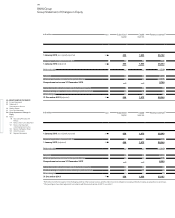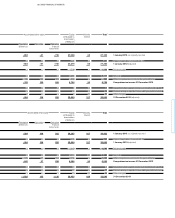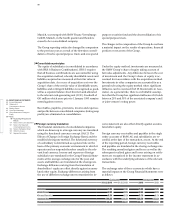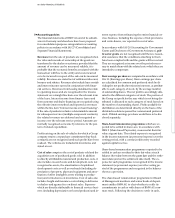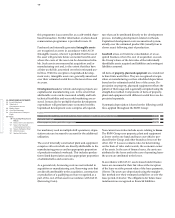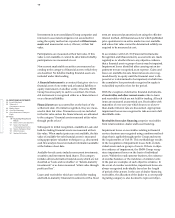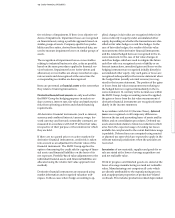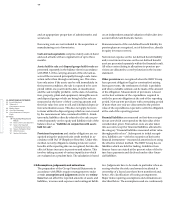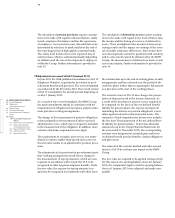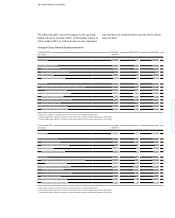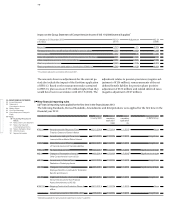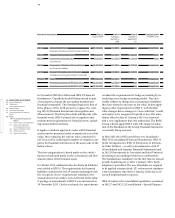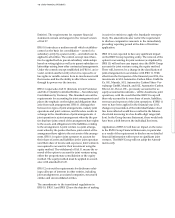BMW 2013 Annual Report Download - page 103
Download and view the complete annual report
Please find page 103 of the 2013 BMW annual report below. You can navigate through the pages in the report by either clicking on the pages listed below, or by using the keyword search tool below to find specific information within the annual report.
103 GROUP FINANCIAL STATEMENTS
tive evidence of impairment. If there is no objective evi-
dence of impairment, impairment losses are recognised
on financial assets using a portfolio approach based on
similar groups of assets. Company-specific loss proba-
bilities and loss ratios, derived from historical data, are
used to measure impairment losses on similar groups of
assets.
The recognition of impairment losses on receivables
relating to industrial business is also, as far as possible,
based on the same procedures applied to financial
ser-
vices business. Impairment losses (write-downs and
allowances) on receivables are always recorded on sepa-
rate accounts and derecognised at the same time the
corresponding receivables are derecognised.
Items are presented as financial assets to the extent that
they relate to financing transactions.
Derivative financial instruments are only used within
the BMW Group for hedging purposes in order to re-
duce currency, interest rate, fair value and market price
risks from operating activities and related financing
requirements.
All derivative financial instruments (such as interest,
currency and combined interest / currency swaps,
for-
ward currency and forward commodity contracts) are
measured in accordance with IAS 39 at their fair value,
irrespective of their purpose or the intention for which
they are held.
If there are no quoted prices on active markets for
derivative financial instruments, credit risk is taken
into account as an adjustment to the fair value of the
financial instrument. The BMW Group applies the
option of measuring the credit risk for a group of finan-
cial assets and financial liabilities on the basis of its
net exposure. Portfolio-based value adjustments to the
individual financial assets and financial liabilities are
allocated using the relative fair value approach (net
method).
Derivative financial instruments are measured using
market information and recognised valuation tech-
niques. In those cases where hedge accounting is ap-
plied, changes in fair value are recognised either in in-
come or directly in equity under accumulated other
equity, depending on whether the transactions are clas-
sified as fair value hedges or cash flow hedges. In the
case of fair value hedges, the results of the fair value
measurement of the derivative financial instruments
and the related hedged items are recognised in the in-
come statement. In the case of fair value changes in
cash flow hedges which are used to mitigate the future
cash flow risk on a recognised asset or liability or on
forecast transactions, unrealised gains and losses on the
hedging instrument are recognised initially directly in
accumulated other equity. Any such gains or losses are
recognised subsequently in the income statement when
the hedged item (usually external revenue) is recog-
nised
in the income statement. The portion of the gains
or losses from fair value measurement not relating to
the hedged item is recognised immediately in the in-
come statement. If, contrary to the normal case within
the BMW Group, hedge accounting cannot be applied,
the gains or losses from the fair value measurement of
derivative financial instruments are recognised imme-
diately in the income statement.
In accordance with IAS 12 (Income Taxes), deferred
taxes are recognised on all temporary differences
between the tax and accounting bases of assets and lia-
bilities and on consolidation procedures. Deferred tax
assets also include claims to future tax reductions which
arise from the expected usage of existing tax losses
available for carryforward to the extent that future usage
is probable. Deferred taxes are computed using enacted
or planned tax rates which are expected to apply in the
relevant national jurisdictions when the amounts are
recovered.
Inventories of raw materials, supplies and goods for re-
sale are stated at the lower of average acquisition cost
and net realisable value.
Work in progress and finished goods are stated at the
lower of average manufacturing cost and net realisable
value. Manufacturing cost comprises all costs which
are
directly attributable to the manufacturing process
and an appropriate proportion of production-related
overheads. This includes production-related depreciation



